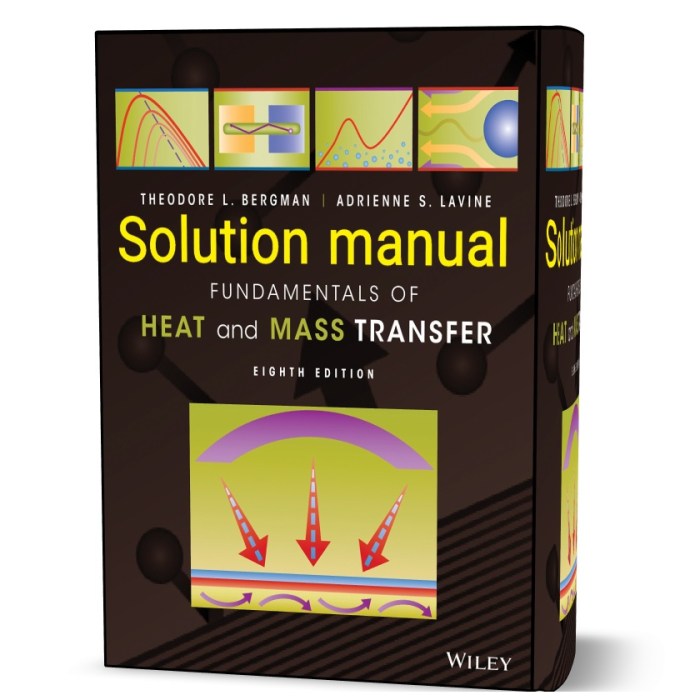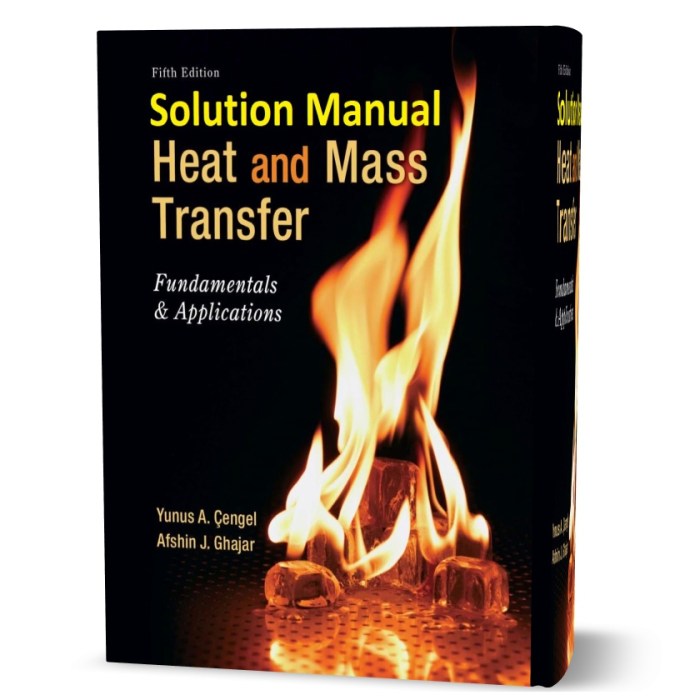Fundamentals of heat and mass transfer 8th edition solutions – Delving into Fundamentals of Heat and Mass Transfer, 8th Edition, this comprehensive guide unveils the fundamental principles and applications of heat and mass transfer, providing an authoritative resource for students, engineers, and researchers alike.
This definitive text covers the entire spectrum of heat and mass transfer phenomena, equipping readers with a deep understanding of the mechanisms and governing equations that underpin these processes. From the foundational concepts of thermodynamics and fluid mechanics to the intricate complexities of conduction, convection, and radiation, this book provides a thorough exploration of the subject.
1. Conceptual Overview
Heat and mass transfer are fundamental processes that occur in nature and engineering systems. Heat transfer is the movement of thermal energy from one region to another due to a temperature difference, while mass transfer is the movement of matter from one region to another due to a concentration difference.
These concepts are crucial in various engineering disciplines, including mechanical, chemical, and biomedical engineering. They play a vital role in the design and analysis of systems involving energy conversion, thermal management, and mass separation processes.
Real-world applications of heat and mass transfer include:
- Power plants: Heat transfer is essential for generating electricity by converting thermal energy into mechanical energy.
- Refrigeration systems: Heat transfer is used to remove heat from a cold space and transfer it to a hot space, providing cooling.
- Chemical reactors: Mass transfer is crucial for mixing reactants and removing products in chemical processes.
- Biological systems: Heat and mass transfer play a vital role in regulating body temperature, nutrient transport, and gas exchange in living organisms.
2. Thermodynamics and Fluid Mechanics

Thermodynamics
Thermodynamics provides the framework for understanding heat transfer processes. The first law of thermodynamics states that energy cannot be created or destroyed, only transferred or converted from one form to another. The second law of thermodynamics states that the entropy of an isolated system always increases over time.
These laws govern the direction and efficiency of heat transfer processes.
Fluid Mechanics
Fluid mechanics deals with the behavior of fluids (liquids and gases) in motion. The principles of fluid mechanics are essential for understanding mass transfer processes.
The conservation of mass, momentum, and energy equations govern the flow and mixing of fluids. These principles are used in the design of fluid systems, such as pumps, pipelines, and heat exchangers.
3. Conduction
Conduction is the transfer of heat through a stationary medium due to a temperature gradient. The rate of heat conduction is proportional to the temperature difference and the thermal conductivity of the medium.
Factors influencing the rate of heat conduction include:
- Temperature difference
- Thermal conductivity of the medium
- Thickness of the medium
- Cross-sectional area of the medium
Applications of Conduction, Fundamentals of heat and mass transfer 8th edition solutions
- Heat sinks in electronic devices
- Thermal insulation in buildings
- Conduction welding
- Heat exchangers
4. Convection

Convection is the transfer of heat or mass by the movement of a fluid. Natural convection occurs due to buoyancy forces caused by temperature or concentration differences, while forced convection occurs due to an external force, such as a pump or fan.
Types of convection include:
- Natural convection
- Forced convection
- Mixed convection
Applications of convection include:
- Cooling of electronic components
- Heating and ventilation systems
- Mass transfer in chemical reactors
- Fluidized bed combustion
5. Radiation
Radiation is the transfer of heat by electromagnetic waves. It does not require a medium and can occur through a vacuum.
Factors influencing the rate of heat radiation include:
- Surface temperature
- Emissivity of the surface
- Area of the radiating surface
- Distance between the radiating and receiving surfaces
Applications of radiation include:
- Infrared heating
- Solar energy collection
- Thermal imaging
- Spacecraft cooling
6. Mass Transfer
Mass transfer is the movement of matter from one region to another due to a concentration difference. It can occur by diffusion, convection, or a combination of both.
Types of mass transfer include:
- Diffusion
- Convection
- Simultaneous diffusion and convection
Applications of mass transfer include:
- Separation of gases and liquids
- Evaporation and condensation
- Membrane separation processes
- Drug delivery
7. Applications in Engineering
Heat and mass transfer concepts are applied in various engineering disciplines, including:
- Mechanical engineering: Design of heat exchangers, boilers, and condensers
- Chemical engineering: Design of chemical reactors, distillation columns, and evaporators
- Civil engineering: Design of heating, ventilation, and air conditioning (HVAC) systems
- Biomedical engineering: Design of medical devices, such as pacemakers and artificial lungs
Emerging applications of heat and mass transfer include:
- Nanotechnology: Heat transfer in nanoscale devices
- Energy efficiency: Development of more efficient heat transfer systems
- Renewable energy: Utilization of heat and mass transfer principles in solar and wind energy systems
- Bioengineering: Tissue engineering and drug delivery systems
FAQs: Fundamentals Of Heat And Mass Transfer 8th Edition Solutions
What are the key concepts covered in Fundamentals of Heat and Mass Transfer, 8th Edition?
This book covers the fundamental principles of heat and mass transfer, including thermodynamics, fluid mechanics, conduction, convection, radiation, and mass transfer.
How can I apply the concepts of heat and mass transfer in engineering practice?
The concepts of heat and mass transfer are essential for designing and analyzing engineering systems in various fields, such as power generation, refrigeration, heating, ventilation, air conditioning, and chemical processing.
What are the benefits of using the 8th edition of Fundamentals of Heat and Mass Transfer?
The 8th edition of this book offers updated content, new examples, and enhanced pedagogical features, providing readers with the most up-to-date and comprehensive resource available.